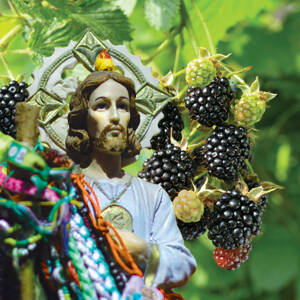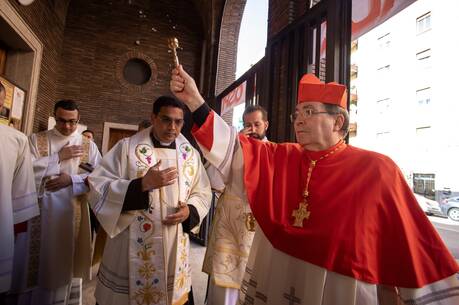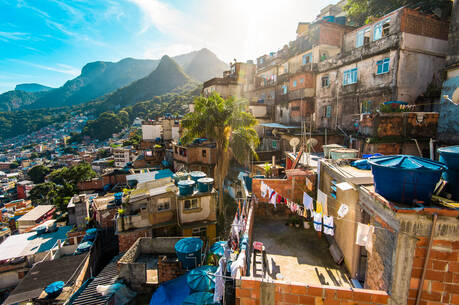A lengthy study of the Victorian poet Christina Rossetti persuaded me to stoop for the first time to yard art. Which is to say, the author of “Goblin Market” and “In the Bleak Midwinter” made me put a statue of St. Jude in my blackberry patch. In truth, I am fundamentally uninterested in nature per se and disdain yard art.
Recently, I have been studying the later works of Christina Rossetti, a poet whom I have always loved, in part because she is so transparently bored, alienated and depressed. (Her poems tend to have titles like “Dead Before Death” and “Sleeping at Last” and opening lines like “When I am dead, my dearest.”) Rossetti’s writings were perhaps the last place I would have expected to find a cure for malaise, and her answer was not one I would have foreseen.
Addressing an individualistic, heavily industrialized and increasingly skeptical late-Victorian England, Rossetti asserts that her readers could escape their alienation from nature and from one another if they would just allow the liturgy to transform their imaginations. Had I come across this idea in a column in a religious magazine, I would have cynically dismissed it as mere devotional sentimentalism, but Rossetti is one of the greatest poets of the last 200 years. Nothing she says about the imagination is to be dismissed lightly. So for the last year or so, I have been trying to work through her logic about the liturgy and apply it, to see, if I can, as she sees.
The Power of Liturgy
If, for Rossetti, liturgical worship has the power to reverse our isolation and alienation, it possesses this power only because in it we encounter the person of Jesus in a particularly intimate and powerful way. She depicts the incarnate Christ as unlocking the meaning of all creation, both by his explicit teachings—which “made the earth bring forth spiritual food for our nourishment”—and by his act of kenosis in taking on material form at all. In Rossetti’s incarnational logic, Christ bridges all our forms of isolation, as he enters and redeems time, sacramentally transforms the physical world and shapes his disparate followers into a united body, the church.
As an Anglo-Catholic, Rossetti sees her church’s liturgy as an expression of a mode of worship that originates with the apostles and apostolic fathers and is still shared in common by Catholics, Anglicans and Orthodox. This liturgical act of worship remains the same in its fundamentals across historical eras, cultures and even ecclesial communions. In the liturgical sacrifice, matter is offered up to God and made divine; in the liturgical calendar, time itself is offered up to God and transformed into an image of eternity. In liturgical prayer, a collection of isolated and messed up individuals becomes the Body of Christ.
This liturgical vision has the potential to transform how we view ourselves and our world. This is why Rossetti and other Victorian Anglo-Catholic poets picture liturgical worship as a classroom in which we must learn again how to read and how to perceive. The liturgy’s combination of Old Testament, New Testament and Gospel passages offers a model for reading Scripture, just as its renaming of days and seasons and sacralizing of bread, wine and water offer models for viewing time and the material world. If we let it, the liturgy could teach us how to relate the faith of the past to that of the present, how to make sacred the common things of earth, how to redeem the times and places in which we find ourselves. I find in this thought an immense challenge to the way I experience the Mass. Certainly, I go to Mass each week hoping to be taught something, some tangible lesson that I can take home with me and incorporate into the life I am already living. But do I go to Mass hoping to learn to see?
Rossetti did. She carried home the method of reading she learned at matins and evensong and used it to reinterpret the mornings and evenings of her life. Most of her devotional prose consists of attempts to understand nature, time and other people in light of the liturgy. In books like Called to Be Saints: The Minor Festivals Devotionally Studied (1881) and Time Flies: A Reading Diary (1888), she uses the liturgy as a key to unlock the symbolic meaning of the world around her.
Spiritual ‘Fruit’
For a basic example, let’s go back to blackberries. The feast of Sts. Simon and Jude falls on Oct. 28, toward the tail end of the liturgical year; they are the last of the Twelve Apostles to be commemorated in the liturgical cycle. Advent is just weeks away, and the Lectionary readings will soon emphasize the Apocalypse, when, as Rossetti writes, “the end of all cometh” and spiritual “fruit” will be “the one thing requisite,” the only thing that really matters. St. Jude, according to tradition a missionary who was violently martyred and the patron saint of hopeless causes, has long been a favorite of the melancholy and beleaguered and well fits the mood of this season of nasty weather and gritty faith. Rossetti sees the late October landscape as the physical expression of her liturgical vision, and fixes on the blackberry plant as an appropriate symbol for St. Jude.
The blackberry is an ugly and invasive plant—as Rossetti points out, it is a mere “bramble” or “thorn bush.” Nonetheless, the wild blackberry plant “without culture or care” produces an abundant harvest; providing “a feast of God’s bestowal not of man’s purveying” to “birds and human wayfarers.” Blackberries, as I have found in my misadventures in gardening, are nearly impossible to kill or even to confine; they are always jumping the fence that separates grass from garden; and if a weed trespasses on the blackberries’ turf, it is the weed that dies. Inspired by the liturgy, Rossetti imaginatively sees the blackberry as an emblem of the long-suffering St. Jude, or more generally of the persecuted church of the Last Days and all days, persisting, spreading and bearing fruit in an almost inverse proportion to the care with which it is treated.
For Rossetti, with her liturgical angle of vision, the whole world—indeed “everything cognizable by the senses”—becomes a mystical symbol. To move just three days down the liturgical calendar to Nov. 1, All Saints’ Day, we honor all holy people known and unknown. This feast causes Rossetti to ponder the merits of a plant similarly ubiquitous and similarly overlooked: common grass. To Rossetti’s meditative mind, grass reveals both the beauty of all we dismiss as ordinary and the strength of all we dismiss as weakness.
Life, in fact, is made livable by the graces and graced people whom we overlook and even thoughtlessly crush. Though the “grasses” are “trodden at all seasons by all feet,” “stripped” of them “earth would lack half her refreshing charm.” The fields of grass, like the masses of unknown saints, bring vitality, color and renewal to the world that ignores them, as they sway with the wind (of the Holy Spirit) and point heavenward toward God. In a late poem Rossetti applies these lessons from the feast of All Saints to the life of the individual Christian. Meditating on the grass, she finds the courage to be one of the forgotten saints, herself paradoxically “strong in patient weakness till the end.”
All Things Holy
Rossetti’s liturgically inspired reading of the world about her is beautiful, creative and even daring. I do not simply accept her symbolic ascriptions; I am not suggesting that we should use her work as a kind of field guide to liturgical horticulture. Blackberries cannot symbolize St. Jude, or grass represent the saints, for me in quite the same way they did for Rossetti. But to adopt Rossetti’s ideas mechanically is in some ways to miss the point. Rossetti is challenging us to learn from the liturgy how to see the whole world as a symbol of God. If we simply adopt her symbols, we have abstracted the result from the method. We have cribbed the answers from the back of the book and have failed to learn to work the problem. We still haven’t learned to see.
The mental discipline of interpreting clock time in light of liturgical time, of material objects in light of sacraments, must start somewhere if it is to take any specific incarnational form at all. While blackberries and grass are as good a place to start as any, each of us will probably start somewhere else.








